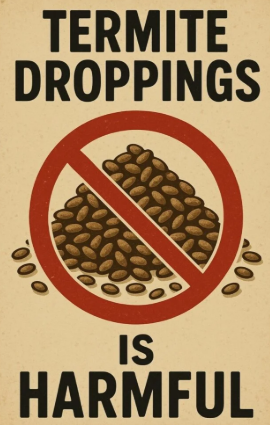If you’ve noticed tiny, pellet-like mounds around your home or business, there’s a chance you’re dealing with a silent intruder. Termite droppings, also known as frass, are one of the earliest and most visible signs of a termite infestation. Understanding what termite droppings look like and how to respond to them can save you from costly damage.
In this guide, we’ll help you identify termite droppings, explain why they appear, and show you how Detect Termite can help protect your home from long-term damage.
What Are Termite Droppings?
Termite droppings are small, hard pellets left behind as termites digest the cellulose found in wood. Unlike many other pests, drywood termites don’t use their waste to build nests. Instead, they push their droppings out of small kick-out holes near their living area. This behavior results in visible piles of frass that homeowners might find on floors, windowsills, or beneath wooden structures.
Appearance of Termite Droppings
Termite droppings typically appear as:
-
Small, oval-shaped pellets
-
Roughly 1 millimeter in length
-
Varied in color: often tan, dark brown, or black
-
Piled up in small mounds that resemble ground pepper or coffee grounds
It’s easy to confuse termite droppings with sawdust or dirt. However, their uniform shape and texture make them stand out upon close inspection.
Why Do Termites Leave Droppings?
Unlike subterranean termites that build mud tubes to stay hidden, drywood termites live and feed inside the wood they infest. To maintain a clean tunnel system within the wood, these termites create kick-out holes through which they expel their waste. This expulsion is crucial for maintaining their nesting conditions.
The appearance of frass means that termites are actively feeding on the wood nearby. It’s not just a sign of past activity — it indicates an ongoing infestation that can worsen over time.
Where Are You Likely to Find Termite Droppings?
Knowing where to look is key to spotting a problem early. Common areas where termite droppings are found include:
-
Window sills and door frames
-
Wooden baseboards and beams
-
Attics with exposed wooden structures
-
Furniture made of untreated wood
-
Crawl spaces or garages
These droppings accumulate below the kick-out holes, which are often very small and difficult to notice without a close look.
Termite Droppings vs. Other Insect Waste
It’s important to distinguish termite frass from the waste of other pests like carpenter ants or roaches. Here’s how they differ:
-
Carpenter ants: Leave behind sawdust-like shavings, not pellets
-
Cockroaches: Leave behind irregularly shaped droppings that often look smeared or soft
-
Termites: Produce hard, pellet-like droppings in consistent shapes and sizes
If you’re unsure, it’s always best to consult a professional. Misidentifying pest waste can lead to ineffective treatment and more extensive damage.
What To Do When You Find Termite Droppings
Discovering termite droppings is a serious warning sign. Here’s what you should do next:
Do Not Ignore the Signs
The presence of termite frass means there’s a colony actively feeding on your property. Ignoring it could allow the infestation to spread further into structural wood, drywall, and even furniture.
Avoid Cleaning Before Inspection
While it may be tempting to clean up the droppings right away, leave them in place until a termite professional can inspect the area. These droppings provide important clues about the severity and location of the infestation.
Call the Experts at Detect Termite
At Detect Termite, we specialize in identifying and eliminating termite infestations before they escalate. Our trained technicians use advanced tools and years of experience to assess the situation thoroughly and offer targeted treatment options that work.
Detect Termite’s Proven Approach to Termite Control
Detailed Inspection
The first step in any treatment is a detailed inspection. Detect Termite’s experts examine both visible signs like droppings and less obvious signs like hollow wood, exit holes, and shed wings. Using state-of-the-art equipment, we identify all areas of infestation to ensure no termite is left behind.
Customized Treatment Plans
No two infestations are the same. That’s why Detect Termite offers customized treatment plans tailored to your home’s unique structure and the type of termite involved. Our options include:
-
Localized spot treatments for minor infestations
-
Whole-structure fumigation for severe cases
-
Preventive treatments to protect against future invasions
Long-Term Monitoring
We don’t just treat the problem — we make sure it stays gone. Our monitoring solutions provide ongoing protection and peace of mind, ensuring your home stays termite-free.
Can You Prevent Termite Droppings from Appearing?
While there’s no way to completely termite-proof a home, there are several things you can do to reduce your risk:
Reduce Moisture Around Wood
Termites are attracted to moist wood. Repair leaks, improve drainage, and use dehumidifiers in crawl spaces to reduce the appeal of your home.
Seal Entry Points
Check your foundation, siding, and vents for gaps or cracks that termites could use to enter. Use caulk or mesh screens to seal these access points.
Treat Wood Surfaces
Consider treating exposed wood with borate-based products that act as termite repellents. These treatments are especially useful in attics and basements.
Schedule Annual Inspections with Detect Termite
Routine inspections from a trusted company like Detect Termite can catch signs of termites before they cause serious damage. Early detection is the best form of prevention.
Why Choose Detect Termite?
When it comes to termite control, experience and precision matter. Detect Termite brings both to every job. Our team is committed to helping homeowners:
-
Identify termite droppings and other signs quickly
-
Understand the risks of infestations
-
Receive reliable, long-term solutions
-
Protect their homes with advanced termite treatments
We’re not just a pest control company — we’re your partner in termite prevention.
Final Thoughts
Termite droppings are more than just a nuisance — they’re a serious red flag that should never be ignored. Recognizing these small but significant signs can make all the difference in protecting your property from expensive repairs and structural compromise.


